
Gagging, Choking & Baby-led Weaning: How to prevent choking when starting finger foods
Our Dietitian shares the research around choking and baby-led weaning, the difference between gagging & choking and how to prevent choking when starting your baby on solids. This post may contain affiliate links which won’t change your price but will share some commission.
As a pediatric dietitian, the most common word I hear from parents about how they feel about starring their baby on finger foods is TERRIFIED. Or maybe it’s a grandparent who’s concerned that you’re doing Baby-led Weaning (BLW).
You, too, might be scared that your baby is going to choke! The good news is that most choking episodes can be prevented.
In this post, we will discuss the research around baby-led weaning and choking, the difference between gagging and choking, tips to prevent choking and how to serve various foods safely when starting complementary foods.
So, let’s dig in!
Gagging
What is gagging?
Gagging and choking are not the same thing, though gagging can be confused with choking. Especially by Grandma, who is shocked that your baby is not following traditional feeding practices!
Gagging is totally normal reflex when starting solid food (no matter the method) and is not dangerous. Gagging is a reflex that’s triggered to prevent swallowing. It closes off the back of the throat and is actually protective against choking.
Gagging is a part of the learning-to-eat process for most infants. It just brings the food up to chew a bit more before going back down. This way, only well-chewed foods are allowed to the back of the throat to be swallowed.
Gagging and BLW
One benefit of baby-led weaning (BLW) and introducing “real” foods sooner is that your baby’s gag reflex is further forward in the mouth. It moves back as your baby ages.
Using this sensitive gag reflex while learning to eat finger food is good, as it prevents choking. Babies will still gag when learning how to eat finger foods, whether you introduce them at six months or hold off until later.
How long does gagging last? Rest assured that if your baby is super-gaggy to start, this will decrease with time and practice!
What to do if your baby is gagging
Don’t pat your baby on the back or dig the food out of their mouth. That might cause the food to fall farther back and lead to actual choking.
You can demonstrate coughing the food up and spitting it out. And try to stay calm and relaxed. If you freak out when your baby gags, so will they, and it will make eating less pleasant.
How to prevent gagging
There’s not a lot you can do while your baby is eating to prevent gagging. But in preparation for learning how to eat, bring your baby to the table starting when they’re about five months old.
Offer them a “hard munchable” to chew on. This is a hard, stick-shaped food like a rib bone, celery or raw carrot that the baby can’t get a bite out of. They’re not actually eating it.
But your baby will feel like they’re at the family table, a part of the meal. The hard munchable will help increase your baby’s awareness of their mouth, where it is and how it works! It will increase the strength of the mouth muscles and may decrease a super-sensitive gag reflex.
What gagging looks like
Here’s a video of what gagging looks and sounds like when starting Baby-led Weaning:
When to get help for gagging
If your baby has been trying out foods for a few weeks and still gags with every bite, you might need a referral to an Occupational Therapist or Speech-Language Pathologist.
Sometimes, babies will gag so hard it causes them to vomit. This can also be normal. They will likely keep eating without a big fuss if you don’t overreact.
Try spacing milk feeding farther away from solids so their tummy isn’t as full at the table. They will be less likely to vomit and won’t lose as many calories if they do!
If your baby exclusively gags every time on solids to the point of vomiting…..you might need to give solids a bit of a break. Maybe your baby isn’t quite ready yet. Wait until they’re six months old and try again.
If they’re over six months, offer purees for a week or two, and then give finger foods another go. While babies can gag on purees, too, it might be a bit easier for them to manage at first. Be truly “baby-led.”
Choking
What is choking?
With true choking, the food mistakenly goes down the airway instead of down the esophagus/food pipe.
A choking baby won’t make any noise (or very little) as their air pipe is blocked. A good reminder that you can consider those loud gagging noises a good thing… When your baby can’t get oxygen, they can’t breathe, and their lips and face will start to turn blue. More on what to do in this situation coming up…
Is it normal for my baby to choke during baby-led weaning?
Choking is not nearly as common as gagging, fortunately!
I’ll get into some stats below when I review the research, but about 13% to 35% of babies in these studies were reported to have choked at least once.
I was lucky and had never experienced choking with any of my children. Until my eldest was about 8, eating beef from Edo in a food court! Luckily, he cleared it himself, although I had to put the baby on the ground quickly (ewww) and was ready to try the Heimlich…
What to do if baby chokes
If another adult or older child is around, yell for help and get them to call 911. If not, call it yourself and start infant CPR right away.
Taking an infant first aid course or CPR class will give you more confidence that you know what to do if this happens. A great online option is Safe Beginnings Infant/ChildSafety/CPR/Choking Prevention course (this is an affiliate link).
The difference between gagging & choking
Gagging Signs
- Baby goes red
- Baby makes loud couching and retching noises
Choking Signs
- Baby is silent or making slight wheezing noises
- Baby appears distressed
- Skin colour may change to blue beginning around the mouth
How to remember the difference between gagging and choking and what to do:
Loud and red let them go ahead. Silent and blue, they need help from you.
Check out my video talking more about gagging vs choking here.
Pocketing Food
If your baby stuffs food into their mouth, this can lead to both gagging and choking. Try and encourage them to chew or to spit it out.
Here are a few more tips if you have a baby who stuffs food to discourage this behavior at meals:
- Slow them down: offer utensils which will take them longer to eat with!
- Have water available and remind them to take sips
- Offer one piece of food at a time, if required.
This is a normal and temporary stage and will likely decrease as the baby’s oral motor skill improves. For more information, check out my post on food pocketing here.
Does BLW increase the risk of choking? The research
A 2021 review study quoted: “Fear of choking was an important factor in parents’ decision not to implement BLW; however, this fear was not supported by the literature.”
Multiple studies have analyzed the risk of choking when using Baby-led Weaning to start solids. Today, I’ll break down two of these studies:
The BLISS Study
BLISS stands for “Baby-Led Introduction to Starting Solids.” This clinical trial on choking was published in the “Pediatrics” journal and titled “ A Baby-led Approach to Eating Solids and Risk of Choking.” This study included 206 families.
The parents answered questionnaires when their baby was 6, 7, 8, 9 & 12 months of age. Questions included the frequency of choking and gagging.
Those who reported choking were asked some follow-up questions about what the child was fed and how the choking was resolved.
A total of 35% of babies choked at least once between 6-8 months old. There was no difference between the two groups in incidences of choking at any of the time periods.
Those that started with Baby-led Weaning gagged more often at six months but less by eight months. The puree group was gagging more by eight months than the BLW group (because they were now learning to eat finger foods, too). You can’t skip the gagging stage!
Of the three incidences of choking in which health care help was required, two babies choked on milk, and one choked on food that was placed in their mouth by a caregiver (not recommended with BLW). This goes to show that it’s possible to choke on anything.
The researchers found that choking hazards were frequently offered in both groups. Not all parents stayed close to supervise their babies.
Dr Amy Brown’s research on choking and baby-led weaning
This observational study was titled “No difference in self-reported frequency of choking between infants introduced to solid foods using a baby-led weaning or traditional spoon-feeding approach. Again, this shows that babies do not choke more with baby-led weaning.
Dr. Brown surveyed 1151 moms with infants between 4-12 months old. The moms reported how solids were introduced (strict BLW, loose BLW or traditional weaning) and the percentage of mealtimes that included spoon-feeding purees to the baby.
Moms also reported if their baby had ever choked, and if so, how many times and on what type of food (smooth puree, lumpy puree or finger food).
The results found that 13.6% of infants (or 155 babies out of the group of 1151) had choked. No significant association was found between the style of starting and choking or the frequency of spoon or puree feeding and choking.
But one interesting finding is that for infants who had choked, those following a traditional weaning approach experienced significantly more choking episodes on finger foods and lumpy purees than infants following either a strict or loose baby-led approach.
Why? BLW mothers are less anxious, so maybe the spoon-feeding parents overinterpreted choking events or provided more assistance for their baby to eat, which can be dangerous. We want them to self-feed.
Or perhaps lower exposure to finger foods leads to more choking because the babies hadn’t as much practice early on when the gag reflex is more sensitive. A good reason to introduce finger foods from the start, whether you use purees or not!
So, it seems the potential risk of BLW is no larger using this alternative method of starting solids than a traditional approach. Great!
Is combo feeding safe?
Health Canada and the National Health Services (in the UK) recommend this combo method of starting solids, including finger foods and purees.
Despite many Baby-led Weaning Facebook groups being adamant that it will cause choking….the research (and my own experience with clients and my kid) has not proven this to be true.
So, if you want to feed pureed food and finger foods – go ahead. It’s not true “Baby-led Weaning,” but labels don’t matter (unless you’re part of a research study).
Just remember when feeding purees to be responsive to baby’s hunger and fullness signals if spoon feeding (when it’s much easier to tend to over-feed more than the baby wants). And offer finger foods to practice with at each meal.
Tips to prevent choking with baby-led weaning
Choking is a risk, no matter how you start solids. But there is a lot you can do to offer a safe variety of foods. Here are some tips to prevent choking:
1) Let your baby feed themselves
Never put a piece of food into your baby’s mouth. If you put food into their mouth, it may immediately fall to the back, without the baby having a chance to control it with their tongue and chew it.
2) Always watch your baby while they eat.
Remember, choking is silent. And sitting down to eat with your baby is one of the benefits of Baby-led Weaning anyway!
3) Offer soft foods.
If food does happen to get past the gag reflex and cause your baby to choke, your baby will be much more likely to cough up soft food.
So steam hard fruits and veggies until soft. Soft foods like bananas or avocados are fine served raw. But test the foods to make sure you can mash them with your tongue on the roof of your mouth. This is called the “squish test.” If the food is harder, ensuring it’s in a safe shape (i.e. grated or sliced thinly) is especially important.
4) Offer safe sizes of food.
It’s common in the baby-led weaning world to hear that you should offer your baby food as a stick shape when they are just starting. This is so that your baby has something to grasp onto before she develops the use of her forefinger and thumb in a pincer grasp to pick up smaller pieces of food.
But here’s why I don’t suggest offering food in the shape of a stick or finger: if a baby bites off a chunk of the stick or finger-shaped food and it gets past his gag reflex, then it is a shape that could become a choking hazard.
So, what is a safer shape for the beginning baby-led weaner? Slice the food thinly, like a potato chip, making sure that it’s thinner than your baby’s pinky fingernail, which works well for foods like apples, sweet potatoes, beets or cucumbers.
If you have a mandolin, this is a perfect tool to use!
5) Remove distractions during meals.
Don’t have toys to play with or the TV during meals, as a distracted baby is likelier to choke. Some families may have to remove the dog during mealtime!
6) Seat Baby Safely.
Use a proper high chair. I preferred not to buckle the high chair (unless there’s a risk of your baby falling or climbing out). That way, you can get them out quickly if needed.
Your baby should be well supported in their high chair. Roll up towels to support your baby if they are leaning to one side or too low. The tray (or table) should come between their nipples and belly button.
Their feet should sit on a footrest. This is an important piece that many people miss.
In this post I talk more about why supportive high chairs are so important, how to modify your high chair and my favourite brands in this post.
High-choking risk foods to avoid for baby-led weaning
In Dr. Amy Brown’s study on BLW and choking, the moms specified which foods their infant had choked on (if any).
The most common finger foods to choke on were hard/snappable foods such as apple slices or carrot sticks (19 incidents) and slippery foods such as banana, melon, avocado (17 incidents).
So, I’ll give an example below of how to safely serve a hard, snappable food (apple) and a soft, slippery food (banana).
The #1 choking hazard for babies: Apples
Apples are the #1 food baby-led weaners choke on.
If you give your baby a full apple, they could take a bite of a perfectly round and hard apple – the potential culprit of choking.
To serve apples to a baby just starting solids, first, peel the apple. Slice thinly and steam so it’s soft.
Use a cheese grater on a raw apple if your baby has a pincer grasp. You can keep the peel on.
This goes for any hard fruits or veggies. The cheese grater makes small shreds that are a safe size.
Soft slippery food: BLW Banana and Avocados
There are a few ways to serve bananas. Since bananas are soft, they aren’t as big of a choking hazard as apples. However, anything slippery could slip past the gag reflex and into an air tube.
To prevent bananas, avocados and melons from being so slippery, coat them in iron-fortified infant cereal or ground flax. This also adds more iron and nutrition! And makes the food easier to pick up.
In terms of shape, you can slice peeled bananas into long strips.
Or peel the banana part way and leave part of the banana sticking out (wash the peel first). While this isn’t quite as safe in terms of shape, it’s easy for the baby to hold, and most will just gum the banana slowly away when starting.
As you can see in this video…
High-risk choking foods & how to serve them safely
- Grapes need to be cut in quarters or at least length-wise. So, these won’t be appropriate until your baby has a pincer grasp and can pick up smaller pieces of food.
- Hot dogs are the most common food that causes choking in small children. If you choose to feed your little one sausages of hot dogs, make sure you slice them the long way down the middle.
- Nut butter is spread thinly on toast or crackers, as it can build up on the palate or form a seal on the windpipe if given by a spoon.
- Foods with strings, like celery and pineapple, can be finely chopped.
- Remove pits from fruit and chop small round fruits like grapes, cherry tomatoes and cherries.
- Whole nuts: finely chop or use as nut butter spread thinly.
- Dried fruit: Chop finely. Or raisins are fine whole once cooked, like in a muffin or oatmeal, as they become soft.
- Bread: bread can be sticky and gummy. So, serve it as a strip of toast. Top with mashed avocado, hummus, or nut butter for a baby safe high-energy-density food.
- You can also use a mesh feeder bag for choking hazards when your baby starts out on solids. They’re suitable for foods like frozen blueberries or mandarin oranges that may be a choking hazard.
When can I serve my baby harder food?
This will depend on your baby’s number of teeth and skill level with eating. As well as your own comfort.
Popcorn, hard candy and whole nuts are suggested to be avoided until age 4.
Summary
Phew! Ok, we’ve learned about what gagging and choking are, the differences and how to deal with them.. Whether baby-led weaners choke more often than spoon-fed babies: they don’t. And if ‘combo feeding’ is safe: it is.
I shared tips to prevent choking and shared baby-led weaning food ideas for how to serve potential choking hazards safely. So now you have safe feeding practices covered.
I hope this information is empowering and will decrease your fear of offering finger foods to your baby.
Want to know even more about using BLW to make starting solids fun, easy & healthy? Click here to register for my free webinar “Benefits & Myths of Baby-led Weaning”
Founder of First Step Nutrition | Registered Dietitian Nutritionist
Jen believes raising happy, well-nourished eaters who have a healthy relationship with food doesn't have to be a battle! She is an author and speaker with 18 years of experience specializing in family nutrition and helps parents teach their kids to try new foods without yelling, tricking, or bribing.
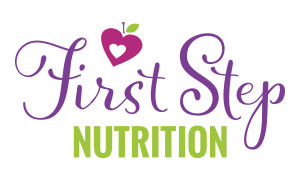




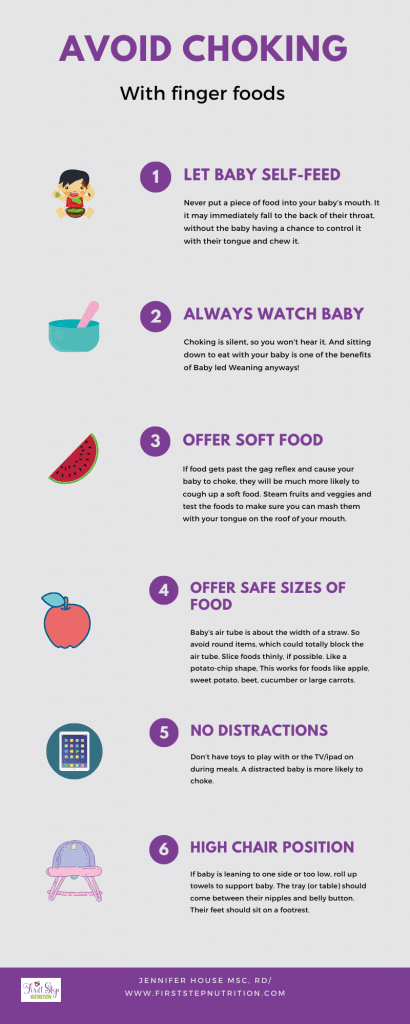
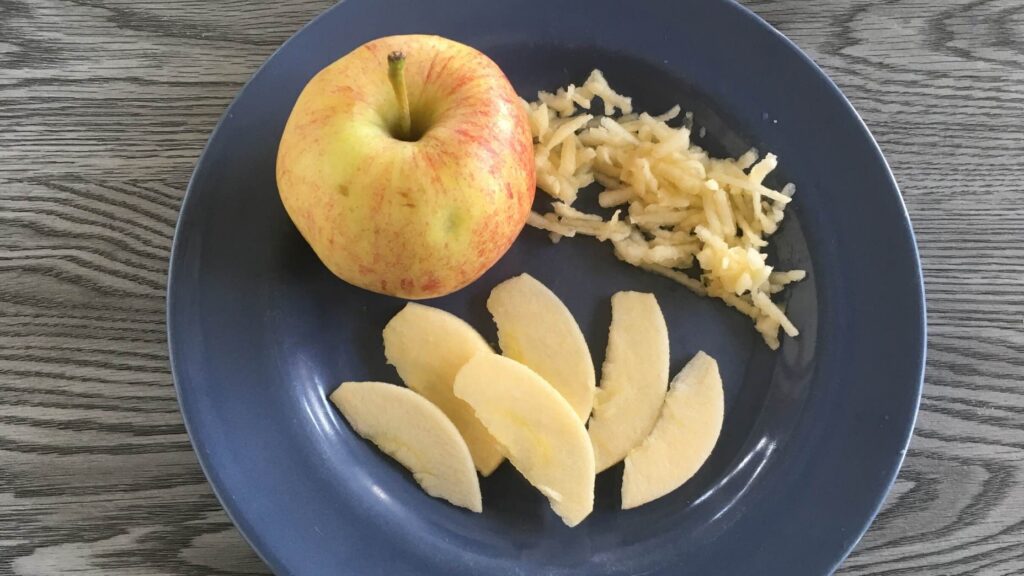
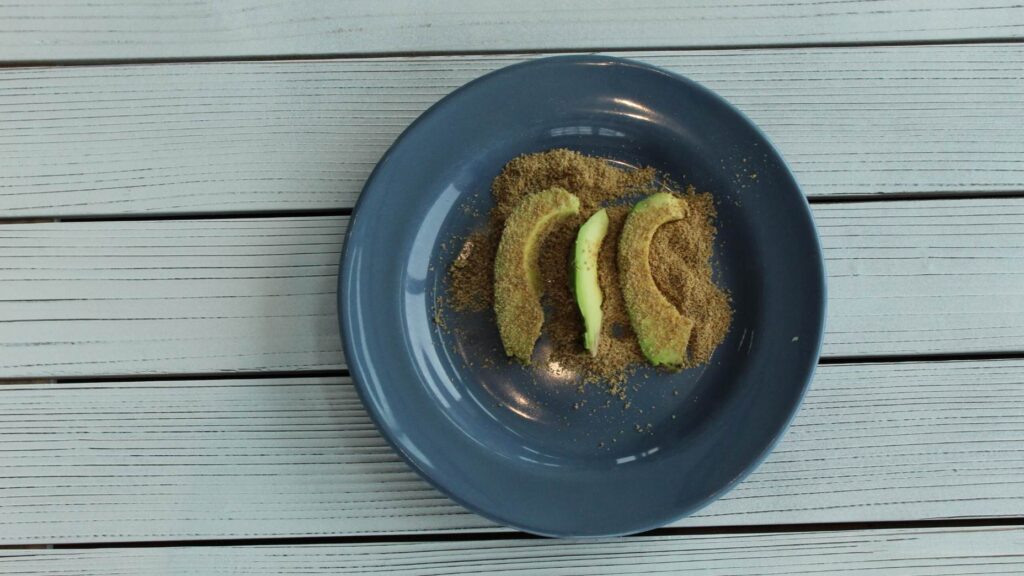
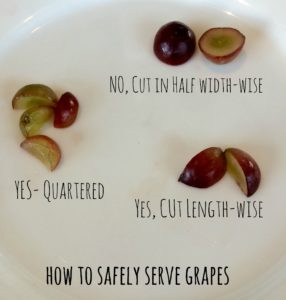

No Comments